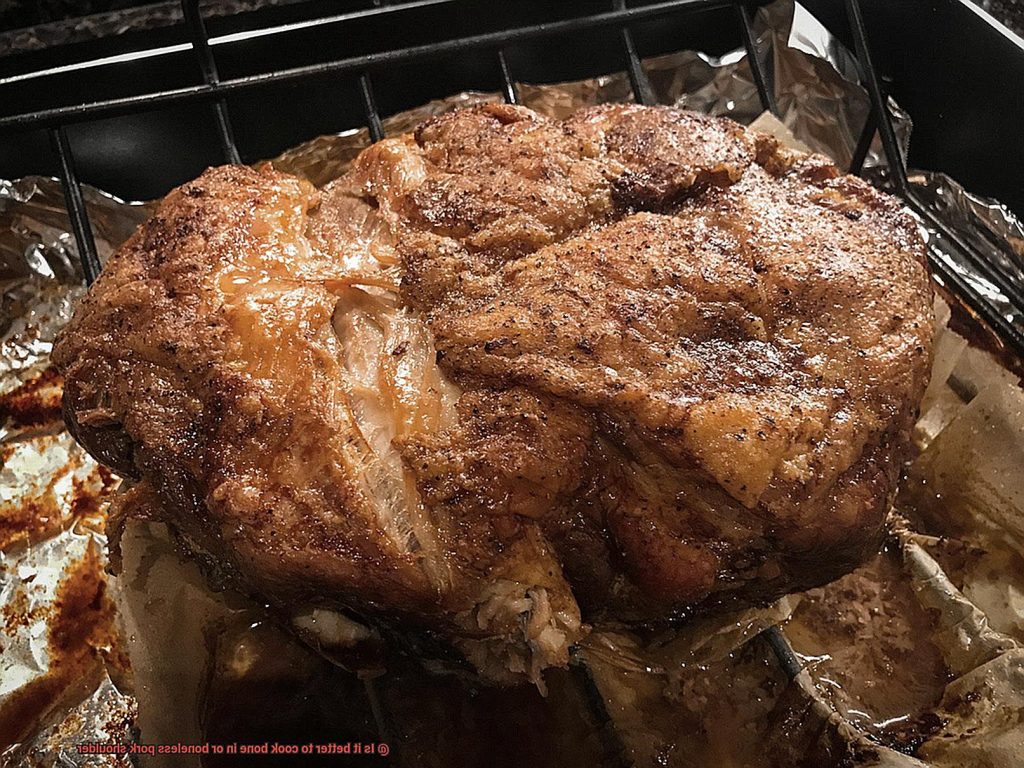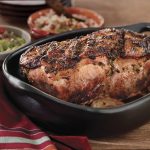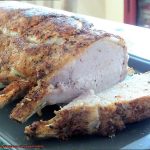Pork shoulder is a true culinary chameleon, perfect for everything from weeknight dinners to special occasions. But when it comes to choosing between bone in or boneless pork shoulder, the decision can be overwhelming for even the most seasoned chef. So, what’s the verdict? Is it better to cook bone in or boneless pork shoulder?
The answer isn’t cut and dry – it depends on your personal preferences and cooking goals. Do you crave tender meat that falls off the bone, or do you prefer a roast that holds its shape when carved? And let’s not forget about flavor – does the bone add an extra dimension of taste?
In this post, we’ll delve into the nuances between bone in and boneless pork shoulder. We’ll examine how each cut affects texture and flavor, so you can make an informed decision for your next meal. Whether you’re planning a slow-cooked barbecue feast or a simple weeknight dinner, we’ve got you covered with expert advice and scientific insight.
So, let’s get started now.
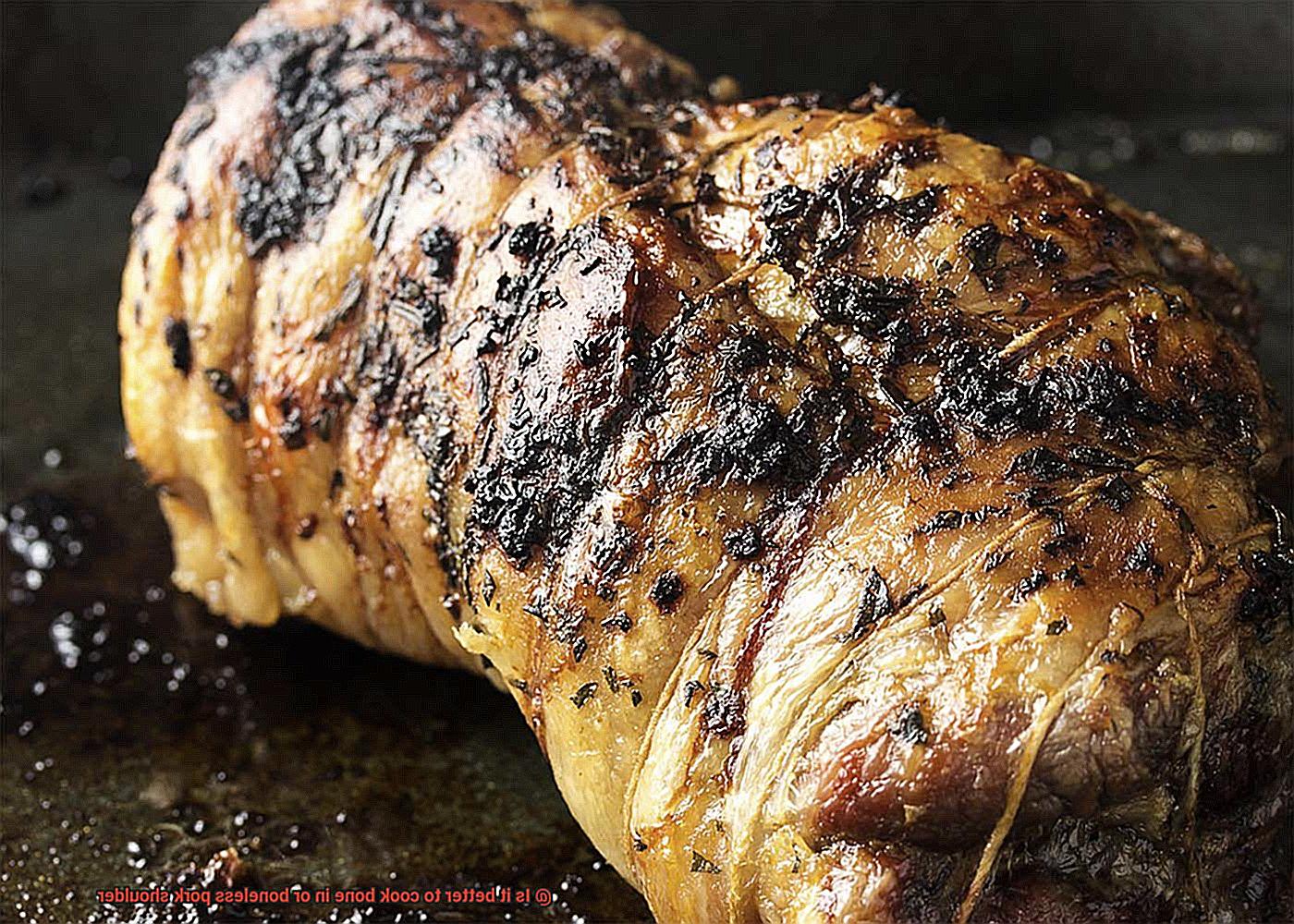
Contents
The Advantages of Cooking Bone-In Pork Shoulder
Pork shoulder is a versatile and delicious cut of meat, but when it comes to cooking it, there’s a debate on whether to choose bone-in or boneless. While both options have their merits, there are some undeniable advantages to using a bone-in cut.
Firstly, bone-in pork shoulder is known for its exceptional flavor. The bone itself contains marrow, which infuses the meat with rich and savory flavors as it cooks. This results in a depth of taste that you just can’t replicate with boneless cuts. And if that’s not enough, the bone acts as a natural insulator that helps to keep the meat moist and tender while cooking. This makes it the ideal choice for low and slow dishes like pulled pork or braised pork shoulder.
In addition to its superior flavor and tenderness, bone-in pork shoulder is also typically less expensive than boneless cuts. This makes it an excellent option for budget-conscious cooks who still want a delicious meal. And since the cuts are usually larger than their boneless counterparts, they’re perfect for feeding a crowd or meal prepping for the week ahead.
Of course, there are some downsides to using a bone-in cut. It can be trickier to cook with because of the bone, and you’ll need to be cautious when carving around it to avoid any mishaps. But for those willing to put in a little extra effort, the rewards are well worth it.
The Disadvantages of Cooking Bone-In Pork Shoulder
When it comes to succulent pork shoulder, the bone-in versus boneless debate is a hot topic. While bone-in pork shoulder has its advantages, there are also some disadvantages that should be taken into consideration.
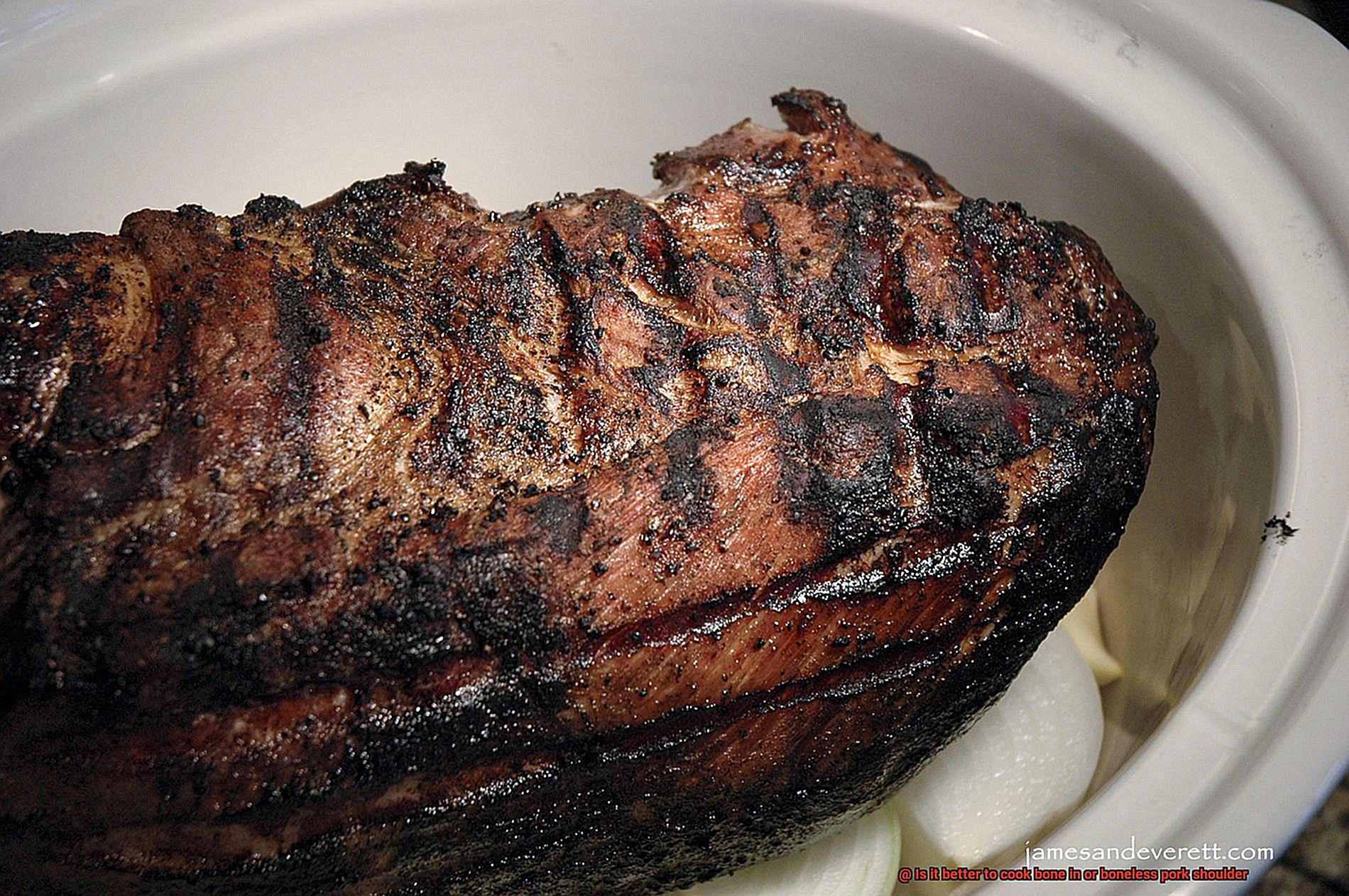
One of the main disadvantages of cooking bone-in pork shoulder is the additional time required. Due to the bones, it takes longer to cook a bone-in cut compared to a boneless one. This can be problematic for busy individuals or those who need to prepare meals quickly.
Another disadvantage of cooking bone-in pork shoulder is the challenge of carving the meat. The presence of bones can make it difficult to separate the meat from the bones, leading to unevenly cooked meat or wasted meat left on the bone. This can be frustrating for home chefs who want to serve up a beautiful and delicious meal.
In addition, bone-in pork shoulder can be more difficult to store and reheat. The bones can make it harder to fit in storage containers or wrap properly, and reheating the meat with bones can take longer and may not result in even heating. This can lead to leftovers that are less tasty than when they were first cooked.
Lastly, personal preferences or dietary restrictions may steer some people towards leaner cuts of meat like boneless pork shoulder. Even though bone-in cuts may offer more flavor and nutrition, those who prefer less fat may opt for boneless cuts instead.
The Advantages of Cooking Boneless Pork Shoulder
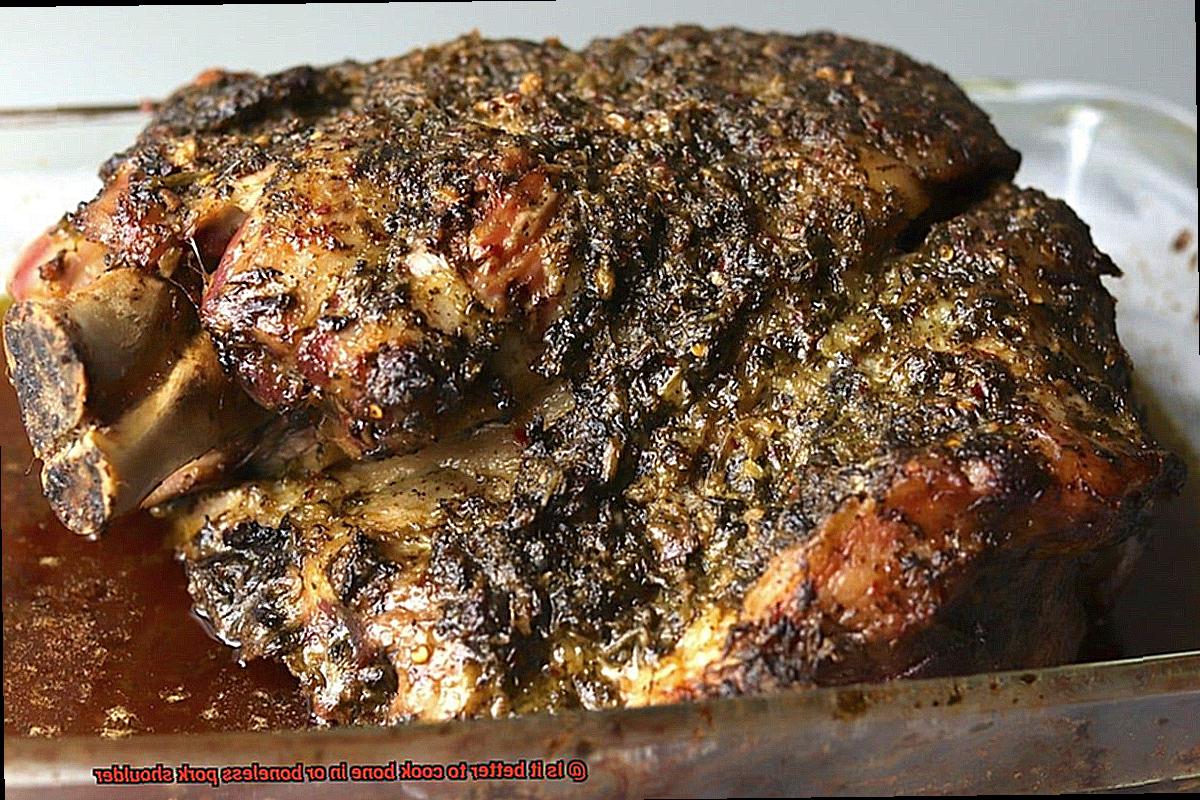
Say goodbye to this problem by choosing boneless pork shoulder for your next meal. This cut offers a number of advantages that make it a great choice for home cooks.
First and foremost, using a boneless cut allows for more even cooking. You won’t have to worry about overcooked or undercooked areas since the heat can penetrate the meat evenly. No more frustration in the kitchen – just perfectly cooked pork every time.
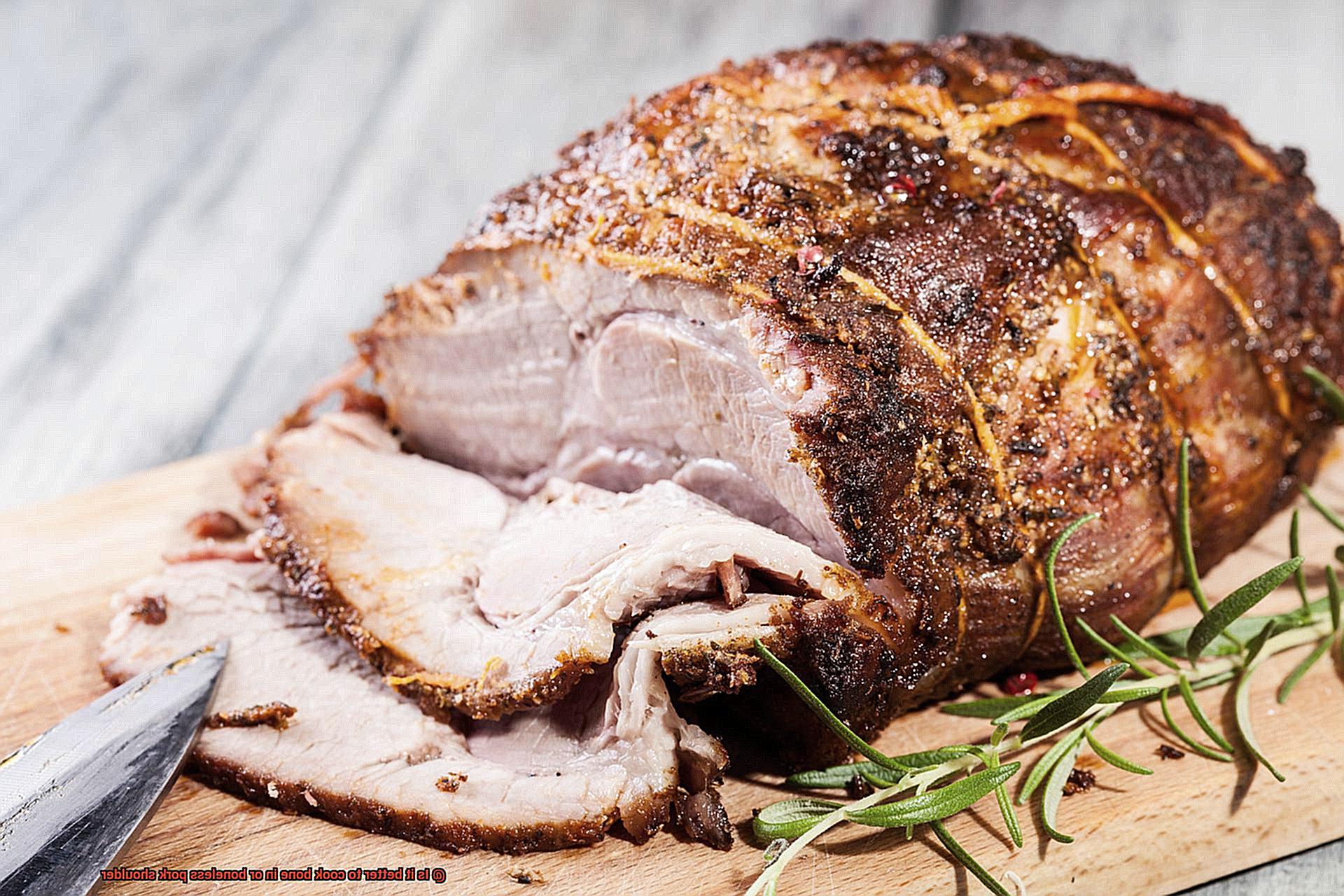
But that’s not all. Preparing and handling boneless pork shoulder is also a breeze. Without the bone, seasoning and marinating are so much easier. There are no nooks and crannies for seasoning to get trapped in, ensuring that every bite is perfectly seasoned and absolutely delicious.
Using a boneless pork shoulder also saves time in the kitchen. With even cooking, you won’t have to constantly check on the meat or adjust the temperature. This gives you more time to focus on other tasks like preparing side dishes or setting the table.
While some people believe that cooking meat with the bone intact can help give it more flavor, there are still plenty of advantages to using a boneless cut of pork shoulder. Ultimately, the decision comes down to personal preference and cooking style.
The Disadvantages of Cooking Boneless Pork Shoulder
Pork shoulder is a versatile and delicious cut of meat, but boneless options may not be the best choice for all cooking methods. While boneless pork shoulder may seem like a convenient option, there are some disadvantages to consider.
One major disadvantage of cooking boneless pork shoulder is that it can be more challenging to keep the meat moist and flavorful. The lack of bone means there’s less natural flavor and fat in the meat, which can lead to a drier, less flavorful end result. This can be especially problematic when slow-cooking or smoking pork shoulder, as the longer cooking time can further dry out the meat.
In addition, using boneless cuts may require more time to cook than bone-in options. The bone helps conduct heat into the center of the meat, allowing it to cook more evenly and quickly. Without it, the meat may require more time in the oven or on the grill to reach its desired temperature.
Finally, it’s worth noting that boneless pork shoulder is often more expensive than bone-in cuts due to the additional processing and preparation required before it’s sold. If you’re looking for a budget-friendly option, a bone-in cut may be a better choice.
How to Choose Between Bone-In and Boneless Pork Shoulder
When it comes to choosing between bone-in and boneless pork shoulder, there are a few important factors to consider. Each option has its own unique characteristics that can impact the flavor, cooking time, convenience, and cost of your meal.
Flavor Difference: Bone-In vs. Boneless Pork Shoulder
If you’re looking for a dish with rich, bold flavors, bone-in pork shoulder is often the way to go. The bone adds depth and richness to the meat during cooking, resulting in a more flavorful dish. However, some people argue that boneless pork shoulder can be less flavorful since there is no bone to add richness. Ultimately, it comes down to personal preference and what you value most in your cooking.
Cooking Time: Bone-In vs. Boneless Pork Shoulder
Another important factor to consider when choosing between bone-in and boneless pork shoulder is cooking time. Bone-in pork shoulder can take longer to cook because the bone slows down the cooking process. On the other hand, boneless pork shoulder cooks faster since there is no bone to impede the heat from reaching all parts of the meat. If you’re short on time, boneless pork shoulder may be the way to go. But if you have some extra time to spare and want maximum flavor and tenderness, then bone-in pork shoulder might be worth the wait.
Convenience: Bone-In vs. Boneless Pork Shoulder
If convenience is a top priority for you, then boneless pork shoulder might be the better option. Without the bone, it’s easier to prepare and carve, saving you time and hassle in the kitchen. On the other hand, if you’re more experienced with carving meat and don’t mind a bit of extra work, then bone-in pork shoulder could be a good choice for you. It’s important to consider your level of comfort and experience when deciding between these two options.
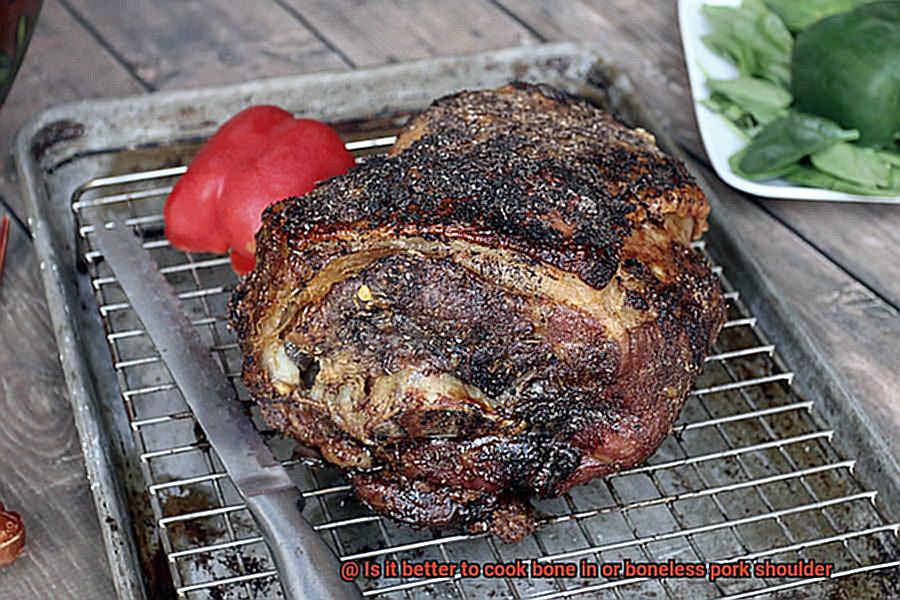
Cost: Bone-In vs. Boneless Pork Shoulder
Cost can also play a role in your decision-making process when it comes to choosing between bone-in and boneless pork shoulder. Generally, bone-in pork shoulder is less expensive than boneless since it requires less processing. However, if you value the convenience of boneless pork shoulder, it may be worth it to pay a little extra for the added ease of preparation and carving.
Personal Preference: Bone-In vs. Boneless Pork Shoulder
Ultimately, the choice between bone-in and boneless pork shoulder comes down to personal preference. Each option has its own unique characteristics that can impact the flavor, cooking time, convenience, and cost of your meal. Think about what’s most important to you in terms of these factors and make your decision accordingly.
Tips for Preparing and Cooking Perfectly Tender and Flavorful Pork Shoulder
Look no further than pork shoulder. But before you fire up the grill or preheat the oven, it’s important to consider whether to use bone-in or boneless pork shoulder. In this article, we’ll explore the differences between the two options and provide tips for cooking perfectly tender and flavorful pork shoulder.
Bone-In versus Boneless:
Cooking with bone-in pork shoulder is like adding a secret ingredient to your dish. The bone acts as a conductor of heat, helping to distribute it throughout the meat, resulting in a juicy and succulent final product. Additionally, the bone can be used to make a rich and flavorful stock for soups and stews. However, if you’re looking for something easier to handle and cook, boneless pork shoulder may be the way to go. It cooks faster and without the bone, there’s no need to work around it when preparing or slicing the meat.
Tips for Cooking Perfectly Tender and Flavorful Pork Shoulder:
No matter which option you choose, there are some general tips to keep in mind for cooking perfectly tender and flavorful pork shoulder. First, season the meat well with salt and pepper before cooking. This not only enhances the flavor of the meat but also helps to create a delicious crust on the outside of the meat. Next, sear the pork on all sides before cooking it low and slow in the oven or on the stovetop. This caramelizes the surface of the meat, adding richness and depth to the dish. Lastly, let the pork rest for at least 10-15 minutes after cooking before slicing into it. This allows the juices to redistribute throughout the meat, resulting in a more tender and moist final product.
Different Cooking Methods:
There are many ways to cook pork shoulder – from grilling to smoking to roasting – but two of the most popular methods are slow-cooking and braising. Slow-cooking involves cooking the pork shoulder for several hours at low heat, which allows the meat to become tender and flavorful. Braising, on the other hand, involves searing the meat and then cooking it in liquid (such as broth or wine) for an extended period of time. This method also results in a tender and flavorful final product.
Serving Suggestions:
Once your pork shoulder is cooked to perfection, it’s time to serve it up. Pulled pork sandwiches are a classic option, but there are many other ways to enjoy this delicious meat. Try serving it with a side of coleslaw or roasted vegetables, or use it as a filling for tacos or burritos. The possibilities are endless.
QOZbuXPC_hw” >
Conclusion
After weighing the pros and cons of both bone-in and boneless pork shoulder, it’s clear that there is no one-size-fits-all answer to this question. It all comes down to what you’re looking for in your meal.
If you want a cut of meat that’s packed with flavor and perfect for feeding a crowd or meal prepping, bone-in pork shoulder is the way to go. The marrow in the bone infuses the meat with rich and savory flavors, making it an excellent choice for slow-cooking or braising. Plus, it’s typically less expensive than its boneless counterpart.
However, cooking with bone-in pork shoulder can be tricky due to the bones, which require careful carving and attention. On the other hand, using boneless pork shoulder allows for more even cooking and easier seasoning and marinating. Plus, it saves time in the kitchen since there’s no need to constantly check on the meat or adjust the temperature.
No matter which option you choose, there are a few key tips to keep in mind. Seasoning well with salt and pepper before cooking is crucial for enhancing flavor. Searing on all sides before slow-cooking or braising results in a delicious crust on the outside of the meat. And letting it rest for at least 10-15 minutes after cooking allows juices to redistribute throughout for a tender and moist final product.
Ultimately, whether you prefer bone-in or boneless pork shoulder depends on your personal preferences and cooking goals.

